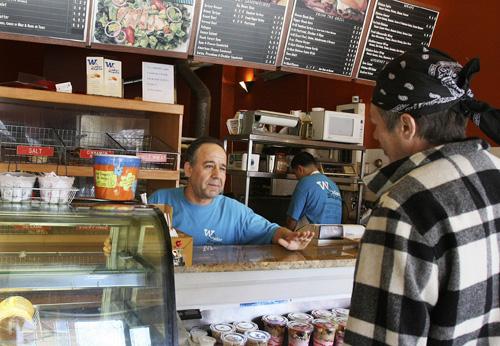Costs of food rise 4 percent, pinch buyers

Owner Sam Iliewat talks with a customer at his Wonder Bagels store in Jersey City, N.J., on Monday. Food prices rose 4 percent nationally in 2007. Max Pasion, The Associated Press
April 15, 2008
NEW YORK – Steve Tarpin can bake a graham cracker crust in his sleep, but explaining why the price for his Key lime pies went from $20 to $25 required mastering a thornier topic: global economics.
He recently wrote a letter to his customers and posted it near the cash register listing the factors – dairy prices driven higher by conglomerates buying up milk supplies, heat waves in Europe and California, demand from emerging markets and the weak dollar.
The owner of Steve’s Authentic Key Lime Pies in Brooklyn said he didn’t want customers thinking he was “jacking up prices because I have a unique product.”
“I have to justify it,” he said.
The U.S. is wrestling with the worst food inflation in 17 years, and analysts expect new data due on Wednesday to show it’s getting worse. That’s putting the squeeze on poor families and forcing bakeries and delis to explain price increases to their customers.
Get The Daily Illini in your inbox!
U.S. food prices rose 4 percent in 2007, compared with an average 2.5 percent annual rise for the last 15 years, according to the U.S. Department of Agriculture. And the agency says 2008 could be worse, with a rise of as much as 4.5 percent.
Higher prices for food and energy are again expected to play a leading role in pushing the government’s consumer price index higher for March.
Analysts are forecasting that Wednesday’s Department of Labor report will show the Consumer Price Index rose at a 4 percent annual rate in the first three months of the year, up from last year’s overall rise of 2.8 percent.
For the U.S. poor, any increase in food costs sets up an either-or equation: Give something up to pay for food.
“I was talking to people who make $9 an hour, talking about how they might save $5 a week,” said Kathleen DiChiara, president and CEO of the Community FoodBank of New Jersey. “They really felt they couldn’t. That was before. Now, they have to.”
For some, that means adding an extra cup of water to their soup, watering down their milk, or giving their children soda because it’s cheaper than milk, DiChiara said.
U.S. households still spend a smaller chunk of their expenses for foods than in any other country.






